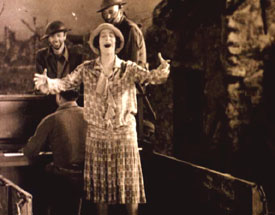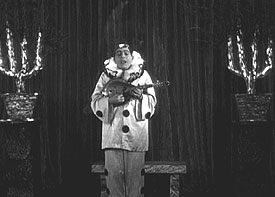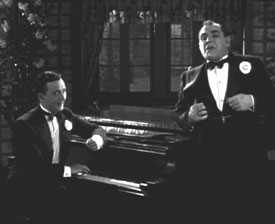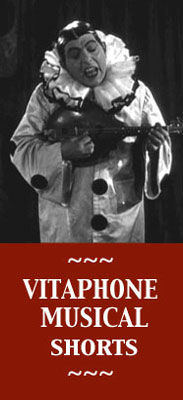 A three-dvd special edition of The Jazz Singer (1928) has two volumes of "extras" not really related to the main film, except being contemporary to the Al Jolsen classic, so produced with the same equipment in the Vitaphone Studio.
A three-dvd special edition of The Jazz Singer (1928) has two volumes of "extras" not really related to the main film, except being contemporary to the Al Jolsen classic, so produced with the same equipment in the Vitaphone Studio.
The third disc is confusingly titled The Jazz Singer Bonus Material Disc 2 (2007) & contains of four hours worth of Vitaphone musical shorts.
A portion of Behind the Lines (1927), which leads off the collection, was unrecoverable due to nitrate decomposition. A screen-capture is shown at the start of the partial restoration, in order to fill in a missing beginning to the film as we hear the intact sound. And before the first number is completed, the still image suddenly springs to life.
Vaudevillian & occasional film star, screenwriter, & composer Elsie Janis is singing & dancing for the troops, from the back of a truck bed, with a pianist behind her at the front of the bed. He's composer W. B. Kernell with whom Elsie was long associated, sometimes writing songs together.
Elsie was a Californian who first set her tiny foot on a stage at age two, & by age eleven was a Vaudeville headliner, initially as "Little Elsie." As she matured & could not rely on cuteness alone, she became a commedienne as well as a song & dance gal.
The song she's performing as Behind the Lines opens is an upbeat wartime diddy about Yanks in France, "When Yankee Doodle Learned to Parley Voux."
She's no beauty, though it seems she had been beautiful in the 'teens. She nevertheless oozes entertainment-culture of the day.
A soldier climbs onto the bed to sing the second diddy, which is in French, as Elsie stands nearby.
When his performance runs its course, Elsie is back at the center of things, singing "In the Army" with great humor, as the Male Chorus of the 107th Regiment (Ohio Volunteers) joins in while she hops about on the back of the truck.
By now there's been a French song & an American song, so it seemed only fair to have a tune for the Limeys in the audience. Elsie invites another soldier up to sing "Goodbye-ee." As the two male soloists weren't otherwise credited, presumedly they were the best guys in the regimental chorus.
Elsie was once greatly beloved for her genuine commitment to entertaining especially the British & American troops. This 1927 one-reeler, however, is a fragment of her stage act about her wartime experiences a decade earlier, & not actually recorded during the war.
It all comes off a bit like an amateur sing-along, nothing special about any of it, except in showing an average vaudeville entertainer of her realm.
This easy-to-watch one-reeler would go well with a reading of her book about her days among the troops, The Big Show: My Six Months with the American Expeditionary Forces (1919).
 In a Pierrot-like Pagliacci outfit & his hair or wig plastered on with shiny black grease, this ugly-ass entertainer stands playing his instrument in Bernardo De Pace: The Wizard of the Mandolin (1927).
In a Pierrot-like Pagliacci outfit & his hair or wig plastered on with shiny black grease, this ugly-ass entertainer stands playing his instrument in Bernardo De Pace: The Wizard of the Mandolin (1927).
The title card mispells his name Bernado. Behind him are two spooky zigzaggy candalabrum or metalic arm-cacti, the decor heightening Bernardo's general creepiness.
Besides this Vitaphone/Warner Brothers one-reeler, Bernardo made similar films for Pathe & for M.G.M. It's hard to believe he was ever popular, he's so repulsive visually -- so much so I'd wager that when this film first played in theaters, mothers had to drag their scared & screaming children out into the lobby & calm them down.
With a shit-eating grin & stiff posture, he's obviously gay as the queen of diamonds. I'll accept that he's playing the mandoliln pretty well, but not with a lot of color. The numbers include "Morning Noon & Night" & "That's Why I Love You" among others.
The only way you can tell the music is supposed to get sadder at one point is because he makes a sissy-whiny face. Then you can tell the music gets happier because he gets the idiot grin back. At one point a string breaks on his mandolin but he keeps going, the best moment in the film.
Because Bernardo seems so unaware that he's a creepy wackjob, the little film actually has considerable appeal as an accidental monster flick.
 Comic singers from Brooklyn billed themselves as "Van & Schenck" on the vaudeville circuit beginning in the 1910s, & sticking it out until the early 1930s. Comic singers from Brooklyn billed themselves as "Van & Schenck" on the vaudeville circuit beginning in the 1910s, & sticking it out until the early 1930s.
At the height of their success in the mid to late 'teens, they had a hit song with "Me & My Gal," & had a spot in a Ziegfield's Follies production.
Their 1923 hit "Carolina in the Morning" won them a radio gig, such as could guarantee them headliner status on the rough vaudeville circuit.
And though there were no more actual hits after 1923, they continued as radio & vaudeville performers until Schenck's unexpected death in Detroit in 1930. Gus Van struggled thereafter as a solo act in the last dregs of vaudeville.
In The Pennant Winning Battery of Songland (1927), Schenck, who pronounced his name Skenk, is the one sitting at piano. They open their set of four tunes with a diddy about pursuing Mary Brown. It's called "Me Too" & is a giddy silly number: "I don't care, I don't mind/ Anywhere she goes you'll find/ Ho ho. Ha ha. Me too..."
They go immediately into a second comic number, "Hard to Get Gertie," which is performed by the Gus Van in an appallingly offensive faux-negro accent: "Hard to get Gertie/ That hard to get gal/ She's pretty then she's flirty/ She's nobody's pal..."
Their third number is played straight, "Because I Love You" sung by the Schenck in the high whiney annoying tenor: "Why am I lonesome, & why am I blue/ Why am I thinking, just thinking of you..."
It's a rather crummy number. Had it been a better romantic tune, it would have failed from this purely clownish fellow who oughtn't even bother attempting something serious.
Lastly it's back to alleged humor with "She Knows Her Onions," a novelty song done with old-man voices.
Van & Schenk's act has definitely dated horribly & probably they weren't all that highly thought of in the 'teens & 'twenties. They made several short films between 1927 & 1929, & who knows but that they might've achieved greater success in cinema if Schenck had lived another decade, but it seems unlikely they could either have become much more than also-rans.
It's nice to see their act, however, as it's of passing interest as an example of ordinary vaudivillian headliners, whose days were numbered with the advent of sound cinema & the waning of vaudeville.
Continue to:
More Vitaphone Shorts among the extras
with the Jazz Singer 80th Anniversary Deluxe Edition
See also:
The Jazz Singer Bonus Disc 1
copyright © by Paghat the Ratgirl
|



